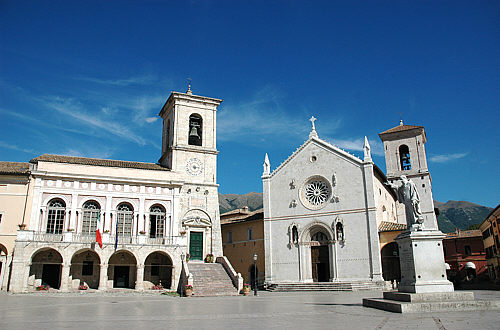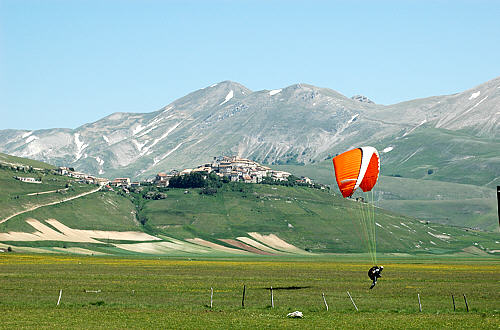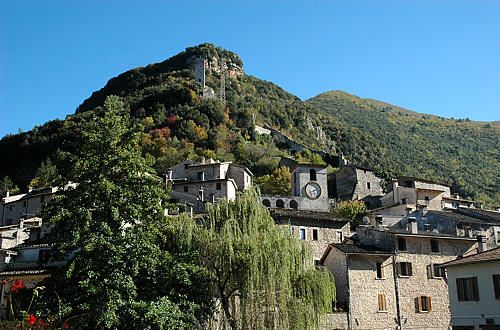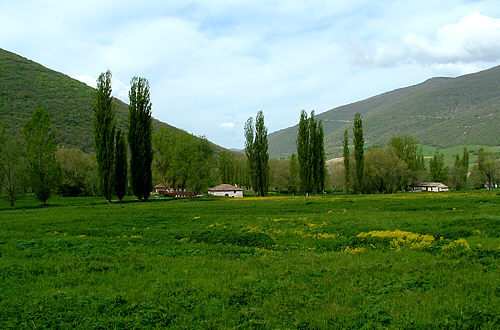Around
Preci
Preci is a hillside castle-town dating back to the 13th century which is located the Saint Eutizio Abbey, to whose fief it belonged before becoming part of Norcia 's territory. Following its ambitions for independence, the castle-town was destroyed twince in the 16th century. Definitive peace with Norcia, which came about in 1555, allowed the castle-town to be restored. This coincided with the flourishing of the surgical school that quickly became very famous. One need only refer to Durante Scacchi, who was Pope Sixtus V's archiater doctor, and his brother Francesco, who operated on the cataract of Queen Elizabeth I in 1588, to appreciate fame of this surgical school. Preci 's surgeons handed down their art from father to son and were specialists in operations involving cataracts and lithotomy (or lithiasis of the bladder). The presences of Preci 's numerous medical families with their palazzos gave a noble air to the town, which conserves the Medieval remains of the two ancient entrance doors and of the "Palazzetto della Comunità".

Preci high
at 2 min. about from the farm

Sant'Eutizio Abbey
at 5 min. about from the farm

Campi Alto
at 10 min. about from the farm
Norcia
The Sabine City of Norcia is located in the most mountainous and picturesque corner of Umbria, in the area of the Monti Sibillini National Park, and preserves intact the reminders of its Roman and Medieval past, starting from the heart-shaped town walls. It has many environmental, artistic, gastronomic and cultural resourcesthat make it both attractive and unique in the eyes of all visitors. Known as the homeland of St. Benedict, First Patron Saint of Europe, and renown for its profound spirituality, Norcia is one of the main destinations for those who love unspoilt nature, sports tranquillity, and the quality of life. It is famous for the "charcuterie" products, i.e. the art of processing pork; this has made the town famous, and Norcia is a varied and sought-after paradise for gastronomists. it boasts excellent products such as IGP-labelled ham, precious black truffle, IGP.labelled Castelluccio lentils, assorted varieties of salumi and cheese.
To be Seen
Castelluccio of Norcia at 25 min. from agriturismSt. Benedetto Basilica (sec. XIV) at 15 min. from agriturism
Castellina (sec. XVI) at 15 min. from agriturism
Tempietto (sec. XIV) at 15 min. from agriturism
Marcite at 15 min. from agriturismo

Panoramic view of Norcia from the road

Piazza di Norcia

Castelluccio di Norcia
Visso
Visso 10 min from the agriturismo
The Name According to tradition, the first settlement was called "Vicus", meaning "place" or "village", accompanied by the adjective "Elacensis", "respectable". The place-name "Vicanum" referred to the communal grazing and firewood-gathering lands (vicana) surrounding a vicus. History • 15th-9th centuries BC: according to some historic sources, the area was already inhabited around 1500 B.C. by Pelasgian peoples living in the Sibillini Mountains; its origins are in any case almost certainly pre-Roman. • 295 B.C.: situated along the ancient border between the Umbrians and Sabines, the vicus was conquered by the Romans. • 494-526 AD: Theodoric established a garrison of Goths in the vicus in order to strengthen his dominion over the “pagi” (villages) of the Valnerina. • 579 AD: the village was subjugated by the Longobard Duchy of Spoleto, which ruled over its mountain villages through minor feudal vassals sent by the stewards in order to maintain peace and order and administer justice. Over the centuries the people of Visso organised themselves into a free Commune, proud and belligerent, continually at war with neighbouring communes until the end of the 1500s. • 1455 AD: the Church, historically well-disposed toward Visso, grants the village various privileges, including independent civil and criminal jurisdiction and, in 1472, perpetual exemption from taxes and excises on imported goods. • 15th - 16th centuries: due to plagues, floods and plundering by mercenary troops, this period of Visso’s history proved so disastrous as to be dubbed the “ruin of Visso”.
The Name According to tradition, the first settlement was called "Vicus", meaning "place" or "village", accompanied by the adjective "Elacensis", "respectable". The place-name "Vicanum" referred to the communal grazing and firewood-gathering lands (vicana) surrounding a vicus. History • 15th-9th centuries BC: according to some historic sources, the area was already inhabited around 1500 B.C. by Pelasgian peoples living in the Sibillini Mountains; its origins are in any case almost certainly pre-Roman. • 295 B.C.: situated along the ancient border between the Umbrians and Sabines, the vicus was conquered by the Romans. • 494-526 AD: Theodoric established a garrison of Goths in the vicus in order to strengthen his dominion over the “pagi” (villages) of the Valnerina. • 579 AD: the village was subjugated by the Longobard Duchy of Spoleto, which ruled over its mountain villages through minor feudal vassals sent by the stewards in order to maintain peace and order and administer justice. Over the centuries the people of Visso organised themselves into a free Commune, proud and belligerent, continually at war with neighbouring communes until the end of the 1500s. • 1455 AD: the Church, historically well-disposed toward Visso, grants the village various privileges, including independent civil and criminal jurisdiction and, in 1472, perpetual exemption from taxes and excises on imported goods. • 15th - 16th centuries: due to plagues, floods and plundering by mercenary troops, this period of Visso’s history proved so disastrous as to be dubbed the “ruin of Visso”.
The economic recovery which followed - thanks to Visso’s geographically strategic position along the commercial trade routes between Rome, Spoleto and the Marches - made possible the construction of beautiful Renaissance-style edifices which can still be seen today. Later, local handicraft and sheep-farming formed the backbone of Visso’s economic prosperity. • 1583 A.D.: Pope Gregory XIII made Visso the permanent seat of the Church’s governorate, under the Apostolic Legate. • 1828 A.D.: the Church confers on Visso the status of city, with all pertaining privileges. • 1860 A.D.: the town is separated from the region of Umbria and incorporated into the Marches.

Collegiate entrance of Santa Maria
XII - XIV century

Fresco of
San Cristoforo

Fields Alto
at 10 min. about from the farm
Valnerina
Valnerina Farm Holidays
Valnerina a 70 kilometre long valley enjoying the wide embrace of tens of other peaceful valley and the transparent caresses of lively torrents that rush down the gentle slopes of vivid green mountains. This simply mystical yet wonderfully earthly image has been forged by Mothr Nature through the River Nera, creating an area between the woods that men - in appreciation of such beauty - have called Valnerina in honour of the river. Since earliest pre-history, man has tenaciously lived in these wary lands that are, however, generous with those who love them. In close collaboration with nature, man has worked toward creating a landscape with an ideal symbiosis between nature and culture. The 15.000 inhabitants of the Valnerina's 300 square kilometres foster life in the small communities. They are proud of today's healty and, rich with history and flavours, where authentic and sacred values such as friendship and hospitality are still considered.
Valnerina a 70 kilometre long valley enjoying the wide embrace of tens of other peaceful valley and the transparent caresses of lively torrents that rush down the gentle slopes of vivid green mountains. This simply mystical yet wonderfully earthly image has been forged by Mothr Nature through the River Nera, creating an area between the woods that men - in appreciation of such beauty - have called Valnerina in honour of the river. Since earliest pre-history, man has tenaciously lived in these wary lands that are, however, generous with those who love them. In close collaboration with nature, man has worked toward creating a landscape with an ideal symbiosis between nature and culture. The 15.000 inhabitants of the Valnerina's 300 square kilometres foster life in the small communities. They are proud of today's healty and, rich with history and flavours, where authentic and sacred values such as friendship and hospitality are still considered.
To be seen
Cascata delle Marmore a 40 min. circa dall'agriturismoVallo di Nera a 25 min. circa dall'agriturismo
Area del Coscerno a 30 min. circa dall'agriturismo
Lago di Piediluco a 45 min. circa dall'agriturismo
Abbazia di S.Pietro in Valle a 25 min. circa dell'agriturismo

Scorcio del paese di Scheggino in Valnerina

Paesino di Cerreto alto.

Chiesa di San Felice di Narco
National Park of the Sibillini Mountains
A mountain chain rising in the heart of Italy and reaching Mt. Vettore (2,476m). A territory where the magic of local nature, history, and culture have contributed in defining a unique and unrepeatable reality. Here, in the kingdom of the mythic Sibilla, the Parco Nazionale Monti Sibillini was established in 1993 (with over 70,000 ha), with the aim to safeguard the environment, promote a social and economic sustainable development, and favour the creation of a "Park suitable to everyone". The wolf, the golden eagle, the peregrine, and a number of endemic species are the most evident elements of a biological richness which, along with the charm of the abbeys and of the Medieval historical centers lying in a crown at the foot of the mountains, have shaped an old and suggestive world where time has stopped to honour a reality of extraordinary beauty.
To be seen
Piani di Castelluccio a 25 min. circa dall'agriturismoLago di Pilato a 25 min. circa dall'agriturismo + escursione
Lago di Fiastra a 30 min. circa dall'agriturismo
Gole dell'Infernaccio a 40 min. circa dall'agriturismo
Santuario di Macereto a 20 min. circa dall'agriturismo

Le Marcite di Norcia nel Parco Nazionale dei Monti Sibillini.

Valle di San Lorenzo alle spalle del Pian Perduto

Scioglimento delle nevi nei pressi dell'infernaccio
Rome






